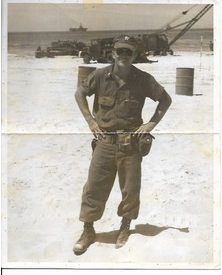Commentary: Airport Construction
What We Learned Stretching A Short Vietnam War Runway
The base for a runway and the basis for solving problems in life

Comedian Bob Hope in a Skyhawk in Chu Lai, Vietnam in 1967. Image: Wikipedia Commons
The biggest thrill I ever experienced was watching the first landing of an A-4 Skyhawk jet fighter on the 23rdday after our arrival on the beach in Chu Lai, in what was then South Vietnam. It was 1965, and I was a young Civil Engineering Corps officer with Mobile Construction Battalion 10. Our mission had been to build a single tactical, or temporary runway and temporary support facilities for Marine Air Group 12. We had been told that we were the first Seabee Battalion to cross the beach in a war zone since World War II.
To land the Skyhawk on such a short runway, they had to be caught in a cable as if they were on an aircraft carrier.
Every time I drive over a cracked highway pavement, my thoughts go back to the problems and failures of those tactical runways in the early years of the Vietnam conflict.
Nowadays, every time I drive over a cracked highway pavement, my thoughts go back to the problems and failures of those tactical runways in the early years of the Vietnam conflict. The Marine Corp. needed the one at Chu Lai until contractor Raymond-Morrison-Knudsen built the more long-lasting concrete runways the following year. My unit, the Delta Company Seabees, had to provide that safe surface for the pilots and flight crews.
It was problem-solving under the most trying conditions in the 110° heat. There was a suicide attack by Vietcong and regular hostile activity. Enemy patrols and company-level combat operations meant that the Marines had to keep a close watch on our operations day and night.
The construction trouble began with the limited choice of local materials. We had sand or laterite, a reddish, clayey material in topsoil, to build the base for the aluminum planks.
 |
| Runway construction in Chu Lai, Vietnam in 1965. Photo Courtesy of John Zander |
By the time the first Skyhawks were landing, we had completed only 2,000 feet of a runway. Because the runway was so short, the marines anchored an arresting gear near the south end to catch the aircraft on a cable. It seemed pretty clever and it enabled the Marines to use the runway at the earliest possible date.
But how would the flight staff send off the aircraft on such a short runway?
We found out a few days later when some of the first Skyhawks were shot aloft using jet-assisted take-off bottles, a method of helping overloaded aircraft into the air by providing additional thrust in the form of small rockets.
Aircraft operations with the smaller Skyhawks continued daily as my Seabee company gradually built the runway up to its final 8,000-ft length. What we didn’t know was the limitations of the tactical runway design for aircraft heavier than the Skyhawks. An A-4 Skyhawk is 24,500 lbs when fully armed; a C-130 Hercules transport airplane is 164,000 lbs before it is loaded.
As we neared completion, the C-130s began making medical evacuations of wounded combat marines and bringing supplies. The rolling loads proved too much. What we built deteriorated as the planes came and went, and the surface sometimes looked like a washboard or shifted as aircraft wheels crossed over it.
 |
| John Zander in Chu Lai, Vietnam in 1965. |
We had built the runway surface with 2 ft by 12 ft Marston Mat aluminum planks with interlocking grooves along each edge. Two inches thick, each plank weighed 144 lbs. There was a non-skid coating on the surface. Handling them required heavy leather gloves because in the 110° heat and sun, they were too hot to touch with our bare hands.
It didn’t take long to realize that the base, not the planks, was failing. Carefully graded loose sand and a compacted layer of laterite simply did not provide a stable base for the C-130s.
We were not the first to face the problem. From 1965 until 1967, the Navy and Army engineering units tried to come up with a simple design using available materials. The Marston Mat planks had been studied for a long time, and soldiers and sailors had trained and rehearsed building with them before leaving the U.S. In a war zone, with larger aircraft, no conclusive standard had been reached for the subgrade. Blame it on the fact that military engineers have to use what is at hand.
We tried to protect the base with plastic sheathing, but the monsoon rains and daily aircraft wheel loads eventually worked the laterite into a soup-like mixture that oozed out at the sides of the runway surface.
So we had to rebuild the base, piece by piece, which meant removing the grooved aluminum planks, the laterite base and replacing the base with a sand-cement mix.
Another Seabee battalion eventually hit on a solution: it bagged the sand and placed the bags in a crowned configuration. The confined sand turned out to be an adequate base for heavier wheel loadings.
The Simplest Solution
The simplest solution, in this case and many others in life, turned out to be best.
Other tests eventually showed that a sheet of vinyl-covered nylon could help secure the subgrade. Also, various bituminous coatings were tried and proved capable of providing a seal and binder for the sand and laterite base. As long as it was sealed with the newly developed vinyl covered nylon sheeting to hold the monsoon rains out of the base, laterite worked well.
Our improvised use of the sand-cement mix required a large amount of cement to be brought in and our progress was slow. With Marine air maneuvers continuing, my unit had to do the the task at night under floodlights. Night work shaved 20 degrees from the outdoor temperature and fortunately the snipers held off, so we were mostly free to work.
Occasionally, even a powerful F-4 Phantom jet fighter would use our tactical runway at Chu Lai.
If anyone can remember the deep signature whooshing sound of a Phantom doing a fly-by, it’s the kind of sound that can give you goosebumps, as it did for me.
Chicago-based John Zander is a consultant to banks on construction projects. He can be reached at marshfield40@gmail.com.



